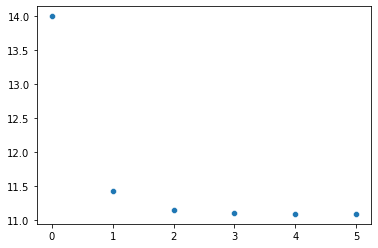import numpy as np
import seaborn as sns- A symmetric matrix has real eigen values
# create a symmetric matrix
def get_random_symmetrix_matrix(n=3):
a = np.random.randint(-10,10, (3,3))
return (a + a.transpose())/2
s = get_random_symmetrix_matrix()
sarray([[-5. , -2.5, -2. ],
[-2.5, -9. , 4.5],
[-2. , 4.5, 3. ]])w, v = np.linalg.eig(s)
w, v(array([ 5.22047873, -5.17812095, -11.04235778]),
array([[-0.2587962 , 0.91904091, -0.29730177],
[ 0.33248317, -0.20422367, -0.92073212],
[ 0.90690654, 0.3371298 , 0.25271333]]))# check the magnitude of the first eigen vector.
print(np.dot(v[0], v[0]))
# check the dot product.
print(np.dot(v[0], v[1]))
# as dimension is one and dot product is close to zero, they are orthonormal1.0
-1.520268617663237e-16Power method to find the dominant eigan value
We initialize a random vector x, usually 1s. We multiply ax and divide the output to make the
error = 0.001
n = 3
s = get_random_symmetrix_matrix(n)
x = np.array([1.0] * n)
def get_dominant_eig_value(a):
eigs = []
eig_old = None
x = np.array([1.0] * a.shape[1])
while True:
x = np.matmul(a,x)
eig = np.max(np.abs(x))
x = x/eig
if eig_old and abs(eig - eig_old) < error:
break
eig_old = eig
eigs.append(eig)
return (eig, eigs)
dom_eig, eigs = get_dominant_eig_value(s)
print(f'dominant eig is {dom_eig} in {len(eigs)} iterations with margin {error}')
sns.scatterplot(x=range(len(eigs)), y=eigs)dominant eig is 11.085887005510221 in 6 iterations with margin 0.001
np.abs(Input In [6] np.abs( ^ SyntaxError: unexpected EOF while parsing